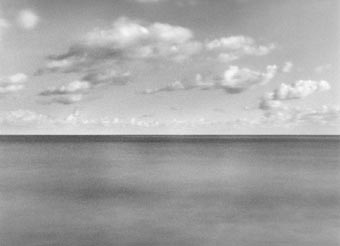|
|
|
|
Seeing the Sea
The coastline where I live has an ancient quality about it. Though high-rises can be found, sticking out like some kind of testament to mankind's hormones, they are no matches for the clumps of rocks that were cast into the sea eons ago. I climb carefully over the slippery rocks, eyeing the crevices kissed by the ebb and flow of the waves. I find a vantage point that is safe yet close enough to the edge to keep me excited. The intuitive mind goes to work. How do the clouds of this day balance with the size of the waves? Is it bright and magnificent or gray and moody? Is it a midday 10-second exposure or the evening glow at three minutes? What is it that drew me into this scene? What keeps me here in freezing cold wind with the smell of damp seaweed under foot? Is it nostalgia or a sense of duty? I go to work with a beat up old tripod and hearty plywood box cameras amidst the salt air. I level the horizon by siting with the top edge of the camera. It is interesting to note that without a viewfinder and setting up the camera as my eye sees the scene, the horizon gets placed in the middle of the picture. Contrary to photography composition rules, it is natural for the horizon to be in the center of the frame. And with pinhole photography it seems to take more of a concentrated effort to get the horizon to be off centered. One of my personally favorite seascape images is called Balancing, precisely because the horizon is directly in the center. The image titled Rocky Coast was taken from a slightly higher vantage point so the composition is more traditional. Practically and aesthetically speaking, in Balancing the sky and sea were of "equal" beauty. In Rocky Coast, the gray sky attracted less attention. A tip Iearnt from a large format "lens" photographer who works with long exposures is to watch the flow of the waves and open and close the shutter during the exposure. I try to imagine how I want the flow of the waves and the interplay of the rocks to look on film. I use this technique often and feel it works well with pinhole. Not only am I painting with light, but with water. It involves me in the scene, and gives me more control over the photographic result. |
